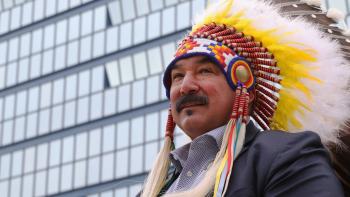Image Caption
Summary
Local Journalism Initiative Reporter
Windspeaker.com
Bob Merasty believes it is time for change.
Merasty is the executive director of the Indigenous Resource Network, which launched its Ownership Changes Everything campaign this past week.
The Indigenous Resource Network was launched in May 2020. The network provides a platform for Indigenous workers, leaders and business owners who support Indigenous engagement in the resource sector.
The network’s Ownership Changes Everything campaign, released last Tuesday, includes a two-minute video. The video can be seen here: https://www.youtube.com/watch?v=t6sfJBH-pUA
Merasty said many Indigenous communities currently face difficulties accessing capital to invest in projects and have equity in them.
“We’ve done our homework and we’ve done our intelligence that says we have to change the narrative,” Merasty said.
The campaign video provides the following perspective.
“Most Indigenous people are not against resource development,” it said. “We’re against being left behind.”
Now that the Ownership Changes Everything campaign has been launched, Merasty said members of the public can get involved by lobbying appropriate provincial and federal ministers to make changes.
“Too many of our communities still can’t access capital to get big projects built,” the video said.
“The Indian Act means houses, land and other assets can’t be used to access loans like other Canadians do.”
He believes Indigenous people have to take the lead, but Merasty says federal politicians are starting to realize changes are necessary, as well.
“I absolutely believe there was political posturing going on before,” he told Windspeaker.com. “But I think this (federal) government is listening. The current government is prepared to work with our Indigenous peoples.”
The Ownership Changes Everything campaign does not just advocate for change. It also provides possible solutions.
For example, the campaign calls for the implementation of an Indigenous Infrastructure Bank to help kickstart capital.
“There are real tangible solutions,” said Merasty, the former chief of Flying Dust First Nation in Saskatchewan from 2012 to 2014.
The campaign also calls for a national Indigenous guaranteed loan program.
“(It) is a step the federal government can take that will help First Nations get the capital needed to become partners and owners of the projects on our own lands,” Merasty said.
The campaign calls for the national guaranteed loan program to be governed by the following principles:
- guaranteed loans at competitive rates for Indigenous communities
- support Indigenous people to have a seat at the table with decision-making power
- no discrimination based on the resource type of projects
- focused on Indigenous goals and values
Merasty said there are numerous people living in poverty in Indigenous communities, including Flying Dust First Nation, right now.
“What we need to do is address the poverty in many of these communities,” he said, adding he believes campaign suggestions can improve lives with the implementation of changes that are being presented.
And the sooner the better.
“The opportunity is there to change the status quo for our people,” Merasty said. “We definitely need to get the word out there. We have to change things for ourselves. We can’t stick with the status quo.”
Merasty believes it only makes sense to have a national Indigenous guaranteed loan program.
“Our communities are faced with a choice between poverty or development,” he said. “Indigenous ownership in major projects is a win-win for industry, Indigenous people and Canadians. A national guaranteed loan program is a no-brainer to move that forward.”
Merasty points to Coastal GasLink, a pipeline project that will transport natural gas to tide water through British Columbia, as a successful venture, including Indigenous participation. A total of 16 communities signed on to the deal.
“We want to showcase success and we want to showcase our responsible projects,” said Merasty.
“We want to showcase how success is possible without barriers.”
After he was the chief of his own First Nation, Merasty was the second vice-chief for the Federation of Sovereign Indigenous Nations, representing 74 First Nations in Saskatchewan from 2015 to 2017.
Local Journalism Initiative Reporters are supported by a financial contribution made by the Government of Canada.

